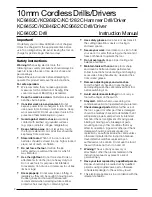
16 ENGLISH
Positive stopper
The positive stopper is useful for setting the designated
angle quickly. Turn the positive stopper so that the
arrow on it points your desired bevel angle (around
22.5°/45°/60°). Loosen the lever and then tilt the tool
base until it stops. The position where the tool base
stops is the angle you set with the positive stopper.
Tighten the lever with the tool base at this position.
►
Fig.12:
1.
Positive stopper
-1°-bevel cutting
To perform -1°-bevel cutting, loosen the clamping
screws and press the levers toward the direction of the
arrow in the figure. Then set the bevel angle to -1° and
tighten the clamping screws.
►
Fig.13:
1.
Lever
Sighting
For straight cuts, align the 0° position on the front of the
base with your cutting line. For 45° bevel cuts, align the
45° position with it.
►
Fig.14:
1.
Cutting line (0° position)
2.
Cutting line
(45° position)
Lighting the lamp
CAUTION:
Do not look in the light or see the
source of light directly.
To turn on the lamp without running the tool, pull the
switch trigger without pressing the lock-off button.
To turn on the lamp with the tool running, press and hold
the lock-off button and pull the switch trigger.
The lamp goes out 10 seconds after releasing the switch trigger.
►
Fig.15:
1.
Lamp
NOTE:
Use a dry cloth to wipe the dirt off the lens of
the lamp. Be careful not to scratch the lens of lamp, or
it may lower the illumination.
Electric brake
This tool is equipped with an electric blade brake. If the
tool consistently fails to quickly stop the circular saw
blade after switch lever release, have tool serviced at a
Makita service center.
CAUTION:
The blade brake system is not a
substitute for blade guard. NEVER USE TOOL
WITHOUT A FUNCTIONING BLADE GUARD.
SERIOUS PERSONAL INJURY CAN RESULT.
Electronic function
The tools equipped with electronic function are easy to
operate because of the following feature(s).
Soft start feature
Soft start because of suppressed starting shock.
Constant speed control
Electronic speed control for obtaining constant speed.
Possible to get fine finish, because the rotating speed is
kept constant even under load condition.
ASSEMBLY
CAUTION:
Always be sure that the tool is
switched off and the battery cartridge is removed
before carrying out any work on the tool.
Hex wrench storage
When not in use, store the hex wrench as shown in the
figure to keep it from being lost.
►
Fig.16:
1.
Hex wrench
Installing sub base
Install the sub base and tighten the clamping screws
securely as shown in the figure.
Always use the tool with the sub base unless when
using the guide rail.
►
Fig.17:
1.
Clamping screw
2.
Sub base
Installing or removing circular saw
blade
CAUTION:
Be sure the circular saw blade is
installed with teeth pointing up at the front of the
tool.
CAUTION:
Use only the Makita wrench to
install or remove the circular saw blade.
1.
Loosen the lever on the depth guide and move the
base down.
►
Fig.18:
1.
Lever
2.
Install the inner flange, ring (country specific),
circular saw blade, outer flange and hex bolt. At this
time, align the direction of the arrow on the blade with
the arrow on the tool.
For tool without the ring
►
Fig.19:
1.
Hex bolt
2.
Outer flange
3.
Circular saw
blade
4.
Inner flange
5.
Arrow on the circular
saw blade
6.
Arrow on the tool
For tool with the ring
►
Fig.20:
1.
Hex bolt
2.
Outer flange
3.
Circular saw
blade
4.
Ring
5.
Inner flange
6.
Arrow on the
circular saw blade
7.
Arrow on the tool
3.
Press the shaft lock fully so that the circular saw
blade cannot revolve and use the hex wrench to tighten
the hex bolt.
►
Fig.21:
1.
Shaft lock
2.
Hex wrench
3.
Loosen
4.
Tighten
To remove the circular saw blade, follow the installation
procedure in reverse.
Summary of Contents for HS011G
Page 2: ...2 Fig 1 Fig 2 Fig 3 Fig 4 Fig 5 Fig 6 3 2 1 Fig 7 ...
Page 3: ...3 1 2 Fig 8 2 1 Fig 9 1 Fig 10 1 1 Fig 11 1 Fig 12 1 Fig 13 1 2 Fig 14 ...
Page 6: ...6 1 2 Fig 30 1 2 1 Fig 31 1 Fig 32 1 Fig 33 Fig 34 1 Fig 35 1 2 3 4 Fig 36 ...
Page 7: ...7 1 2 3 Fig 37 1 Fig 38 1 2 1 Fig 38 1 2 1 2 Fig 39 Fig 40 1 Fig 41 ...
Page 8: ...8 1 2 Fig 42 1 Fig 43 1 Fig 44 1 2 1 Fig 38 1 2 1 2 Fig 45 1 1 2 Fig 46 ...
Page 9: ...9 1 1 Fig 47 1 2 Fig 48 1 Fig 49 1 1 2 A B Fig 50 ...
Page 154: ...154 ...
Page 155: ...155 ...
















































